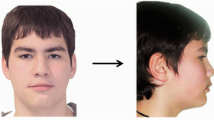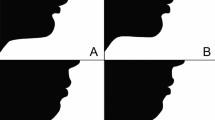Abstract
Objectives
To measure the effect of orthognathic surgery on Class II:1 profile silhouette esthetics and to identify pretreatment parameters and thresholds for consistent esthetic improvement.
Methods
Pre- and posttreatment black profile silhouettes of 20 patients with Class II:1 malocclusion who had received combined orthodontic/orthognathic treatment were evaluated retrospectively by 20 European orthodontists and laypeople each using a visual analogue scale (VAS). A variety of pretreatment skeletal and facial angles were measured cephalometrically and on the silhouette profiles. Descriptive statistics and Pearson’s correlation coefficients were calculated.
Results
The population showed a mean VAS improvement of 12.6%. VAS changes were significantly and directly related to pretreatment ANB in all evaluator groups (r = 0.48–0.59), whereas the interrelation with the degree of pretreatment profile convexity angle was less clear and statistically significant for the orthodontic evaluators only (r = −0.34 to −0.51). The highest correlation coefficients in all evaluator groups were seen for the relationship with pretreatment VAS scores (r = −0.64 to −0.73).
Conclusion
The lower the pretreatment VAS score and the profile convexity angles or the larger the pretreatment ANB angles were, the more the VAS improved. Pretreatment thresholds for consistent improvements were as follows: VAS score < 20 mm, ANB > 8°, and profile angle ≤ 155°.
Zusammenfassung
Ziel
Erfassung der Auswirkung einer kombiniert kieferorthopädisch/kieferchirurgischen Klasse-II:1-Behandlung auf das Gesichtsprofil sowie Identifikation prätherapeutischer Faktoren und Grenzwerte, die eine definitiv vorhersagbare Verbesserung der Profilästhetik versprechen.
Methode
Aus den prä- und posttherapeutischen Profilfotos von 20 kombiniert kieferorthopädisch/kieferchirurgisch behandelten Klasse-II:1-Patienten wurden schwarze Scherenschnittprofile angefertigt. Diese wurden mittels visueller Analogskala (VAS) von jeweils 20 europäischen Kieferorthopäden und Laien beurteilt. Diverse prätherapeutische skelettale und faziale Parameter wurden kephalometrisch und anhand der Scherenschnittprofile bestimmt. Die statistische Auswertung erfolgte deskriptiv und mit dem Korrelationskoeffizienten nach Pearson.
Ergebnisse
Die untersuchte Patientengruppe zeigte eine mittlere VAS-Verbesserung von 12,6%. In allen Beurteilergruppen korrelierten die VAS-Veränderungen signifikant und direkt mit dem prätherapeutischen ANB-Winkel (r = 0,48 bis 0,59), der Zusammenhang mit der prätherapeutischen Profilkonvexität dagegen war weniger deutlich und nur in der kieferorthopädischen Beurteilergruppe statistisch signifikant (r = −0,34 bis −0,51). Die höchsten Korrelationskoeffizienten aller Beurteilergruppen waren für den Zusammenhang von post- und prätherapeutischen VAS-Beurteilungen zu beobachten (r = −0,64 bis −0,73).
Schlussfolgerung
Je niedriger der prätherapeutische VAS-Wert und der Profilkonvexitätswinkel waren bzw. je größer der prätherapeutische ANB-Winkel, desto höher war die VAS-Verbesserung. Als prätherapeutische Grenzwerte für eine konstante Profilverbesserung erwiesen sich ein VAS-Wert < 20 mm, ein ANB-Winkel > 8° und ein Profilkonvexitätswinkel ≤ 155°.





Similar content being viewed by others
References
Abu Arquob SH, Al-Khateeb SN (2011) Perception of facial profile attractiveness of different antero-posterior and vertical proportions. Eur J Orthod 33:103–111
Arnett GW, Bergman RT (1993) Facial keys to orthodontic diagnosis and treatment planning, Part II. Am J Orthod Dentofac Orthop 103:395–411
Arpino VJ, Giddon DB, Begole EA, Evans CA (1998) Presurgical profile preferences of patients and clinicians. Am J Orthod Dentofac Orthop 114:631–637
Barrer JG, Ghafari J (1985) Silhouette profiles in the assessment of facial esthetics: a comparison of cases treated with various orthodontic appliances. Am J Orthod 87:385–391
Brons R (1998) Facial harmony—standards for orthognathic surgery and orthodontics. Quintessence Publishing Co Ltd., London
Burcal RG, Laskin DM, Sperry TP (1987) Recognition of profile change after simulated orthognatic surgery. J Oral Maxillofac Surg 45:666–670
Cox NH, van der Linden FPGM (1971) Facial harmony. Am J Orthod 60:175–183
Czarnecki ST, Nanda RS, Currier GF (1993) Perceptions of a balanced facial profile. Am J Orthod Dentofac Orthop 104:180–187
De Smit A, Dermaut L (1984) Soft-tissue profile preference. Am J Orthod 86:67–73
Dunlevy HA, White RP Jr, Turvey TA (1987) Professional and lay judgment of facial esthetic changes following orthognathic surgery. Int J Adult Orthodon Orthognath Surg 2:151–158
Edler R, Agarwal P, Wertheim D, Greenhill D (2006) The use of anthropometric proportion indices in the measurement of facial attractiveness. Eur J Orthod 28:274–281
Foster EJ (1973) Profile preferences among diversified groups. Angle Orthod 43:34–40
Hockley A, Weinstein M, Borislow AJ, Braitman LE (2012) Photos vs silhouettes for evaluation of African American profile esthetics. Am J Orthod Dentofac Orthop 141:161–168
Johnston C, Hunt O, Burden D, Stevenson M, Hepper P (2010) Self-perception of dentofacial attractiveness among patients requiring orthognathic surgery. Angle Orthod 80:361–366
Kerr WJS, O’Donnell JM (1990) Panel perception of facial attractiveness. Br J Orthod 17:299–304
Knight H, Keith O (2005) Ranking facial attractiveness. Eur J Orthod 27:340–348
Maple JR, Vig KWL, Beck FM, Larsen PE, Shanker S (2005) A comparison of providers’ and consumers’ perceptions of facial-profile attractiveness. Am J Orthod Dentofac Orthop 128:690–696
Mihalik CA, Proffit WR, Phillips C (2003) Long-term follow-up of Class II adults treated with orthodontic camouflage: a comparison with orthognathic surgery outcomes. Am J Orthod Dentofac Orthop 123:266–278
Montini RW, Mc Gorray SP, Wheeler TT, Dolce C (2007) Perceptions of orthognathic surgery patient’s change in profile. A five year follow up. Angle Orthod 77:5–11
Naini FB, Donaldson ANA, McDonald F, Cobourne MT (2012) Assessing the influence of chin prominence on perceived attractiveness in the orthognathic patient, clinician and layperson. Int J Oral Maxillofac Surg 41:839–846
Naini FB, Donaldson ANA, Cobourne MT (2012) Assessing the influence of lower facial profile convexity on perceived attractiveness in the orthognathic patient, clinician, and layperson. Oral Surg Oral Med Oral Pathol Oral Radiol 114:303–311
Naini FB, Donaldson ANA, Cobourne MT, McDonald F (2012) Assessing the influence of mandibular prominence on perceived attractiveness in the orthognathic patient, clinician, and layperson. Eur J Orthod 34:738–746
Ng D, De Silva RH, Smit R, De Silva H, Farella AM (2013) Facial attractiveness of skeletal class II patients before and after mandibular advancement surgery as perceived by people with different backgrounds. Eur J Orthod 35:515–520
Nomura M, Motegi E, Hatch JP, Gakunga PT, Ng’anga’a PM, Rugh JD, Yamaguchi H (2009) Esthetic preferences of European American, Hispanic American, Japanese, and African judges for soft-tissue profiles. Am J Orthod Dentofac Orthop 135:S87–S95
Pancherz H, Ruf S (2008) The Herbst appliance—research-based clinical management. Quintessence Publishing Co Ltd., London
Phillips C, Trentini CJ, Douvartzidis N (1992) The effect of treatment on facial attractiveness. J Oral Maxillofac Surg 50:590–594
Proffit WR, Fields HW, Sarver DM (2012) Contemporary orthodontics, 5th edn. Elsevier Ltd., Oxford
Proffit WR, Phillips C, Douvartzidis N (1992) A comparison of outcomes of orthodontic and surgical-orthodontic treatment of class II malocclusion in adults. Am J Orthod Dentofac Orthop 101:556–565
Reyneke JP, Ferreti C (2012) Clinical assessment of the face. Semin Orthod 18:173–186
Shell TL, Woods MG (2003) Perception of facial esthetics: a comparison of similar class II cases treated with attempted growth modification or later orthognathic surgery. Angle Orthod 73:365–373
Shelly AD, Southard TE, Southard KA, Casko JS, Jakobsen JR, Fridrich KL, Mergen JL (2000) Evaluation of profile esthetic change with mandibular advancement surgery. Am J Orthod Dentofac Orthop 117:630–637
Sinko K, Jagsch R, Benes B, Fischmeister F, Ewers R (2012) Facial aesthetics and the assignment of personality traits before and after orthognathic surgery. Int J Oral Maxillofac Surg 41:469–476
Spyropoulos MN, Halazonetis DJ (2001) Significance of the soft tissue profile on facial esthetics. Am J Orthod Dentofac Orthop 119:464–471
Tsang ST, McFadden LR, Wiltshire WA, Pershad N, Baker AB (2009) Profile changes in orthodontic patients treated with mandibular advancement surgery. Am J Orthod Dentofac Orthop 135:66–72
Tucker MR (1995) Orthognathic surgery versus orthodontic camouflage in the treatment of mandibular deficiency. J Oral Maxillofac Surg 53:572–578
Author information
Authors and Affiliations
Corresponding author
Ethics declarations
Conflict of interest
The authors state that there are no conflicts of interest.
Ethical statement
The study protocol was approved by the ethical committee of the Justus-Liebig-University Gießen (No. 145/13). This article does not contain any studies with human participants or animals performed by any of the authors.
Electronic supplementary material
Below is the link to the electronic supplementary material.
Rights and permissions
About this article
Cite this article
Klaus, K., Heumann, C. & Ruf, S. Effect of orthognathic surgery on profile esthetics in Class II:1 malocclusions. J Orofac Orthop 78, 472–479 (2017). https://doi.org/10.1007/s00056-017-0099-8
Received:
Accepted:
Published:
Issue Date:
DOI: https://doi.org/10.1007/s00056-017-0099-8




